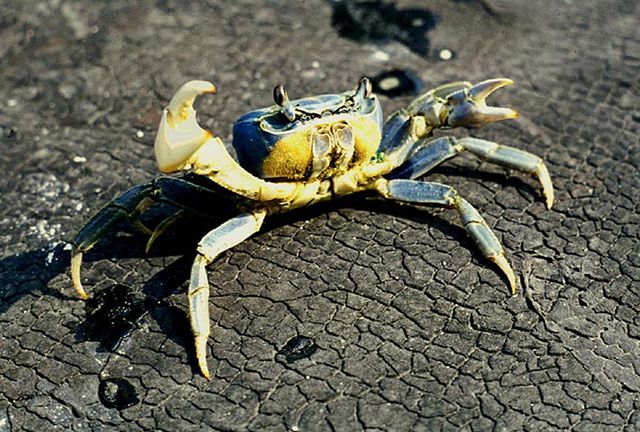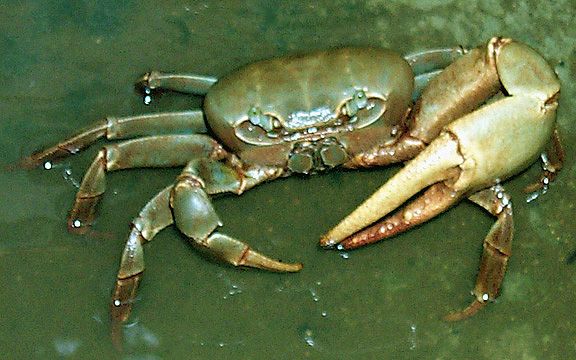Description
The giant land crab is the largest of Florida's semi-terrestrial crabs. This animal can measure up to 6 in (15 cm) across its carapace (Figure 1). In its juvenile form, the crab is dark brown, purple, or orange. As an adult, it is a bluish-gray color. Females sometimes appear light gray or white (Figure 2). One claw is larger than the other, and the walking legs are sparsely hairy.

Credit: Florida Fish and Wildlife Conservation Commission 1999

Credit: Alan Cressler, https://www.flickr.com/photos/alan_cressler/
Range
The natural range of the land crab is Bermuda, throughout the Caribbean Sea, Texas, and southern Florida. In southern Florida, these crabs occur in low-lying areas of coastal counties. They rarely are found more than 5 miles from the coast.
Habitat and Food
As adults, land crabs are terrestrial (land-dwelling) and are found as far as 5 miles from the shoreline, returning to the sea only to drink or breed. They live in burrows several feet deep or at least to a level that will allow water to seep in for moisture. Giant land crabs are primarily vegetarians, preferring tender leaves, fruits, berries, flowers, and some vegetables. Occasionally, they will eat beetles or other large insects.
Reproduction
Blue land crabs reach sexual maturity in approximately 4 years. Peak reproductive activity occurs during full moons in summer. After mating, an adult female lays her eggs but carries the egg mass beneath her body for approximately 2 weeks prior to migrating to the ocean and releasing the eggs into shallow inshore waters (Figure 2). A female may produce 300,000–700,000 eggs per spawn, but very few larvae survive to become small crabs. The larvae are eaten by fish and other aquatic animals. In Florida, the spawning season (and female migration to the ocean) lasts from June to December, peaking in October and November. Once the eggs hatch, the tiny larvae are carried out to sea. The development stage (from larvae to small crab) takes about a month out in the ocean, and by that time, the currents can carry a concentration of larvae quite far before depositing young crabs on another shore. This phenomenon sometimes looks like an invasion of young land crabs.
Damage and Control
Land crabs are by nature shy and pose no threat to humans unless caught and handled. Then they are capable of inflicting a memorable pinch. One of the most unusual features of the giant land crab, its burrowing behavior, also makes it a nuisance to humans living close to the shore. The adult life of the land crab is spent away from saltwater. The adult will dig burrows 3 to 5 in (8 to 13 cm) wide and up to 5 ft (1.5 m) deep. These burrows can be damaging to lawns and gardens. Control of these crabs by chemical means is dangerous to humans and their environment. No chemicals are registered for control of land crabs because of the possible negative effects on groundwater quality.
Because of state regulations (see below), removal of crabs is limited to only the open season from November 1 of each year through June 30 of the following year. No crabs can be removed during the closed season beginning on July 1 and continuing through October 31 of each year. Note, by law (statute 68B-54.002), blue land crabs can only be caught by hand or with the use of a landing or dip net.
Population Trends and Conservation Issues
Where land crabs are exploited for food, there is anecdotal information that population levels are declining. The blue land crab is exploited as a food source throughout the Bahamas and the Caribbean. In these areas, populations have been reported to be declining. Puerto Rico has established a minimum size limit and prohibited harvesting blue land crabs between July 15 and October 15. Also, state forests and reserves in Puerto Rico are off limits to crab harvesting.
In Florida, the Fish and Wildlife Conservation Commission has received anecdotal reports that in certain areas of south and central Florida, harvesting effort has increased. Apparently, one person can catch hundreds of crabs per night, and harvesting effort increases as migration periods approach (June–December). There are also reports that land crabs are being harvested in commercial quantities, 300-400 per day.
As a result, there is a concern about blue land crab populations. The Florida Fish and Wildlife Conservation Commission has passed a rule to limit the take of blue land crabs:
68B-54.002 Statewide Open and Closed Seasons for Harvesting Blue Land Crabs.
(1) Blue Land Crabs shall only be harvested during the open season, which is from November 1 of each year through June 30 of the following year.
(2) No person shall harvest, attempt to harvest, or possess any blue land crab during the period beginning on July 1 and continuing through October 31 of each year.
Bag Limit—No person shall harvest in any one day or possess at any time more than 20 blue land crabs.